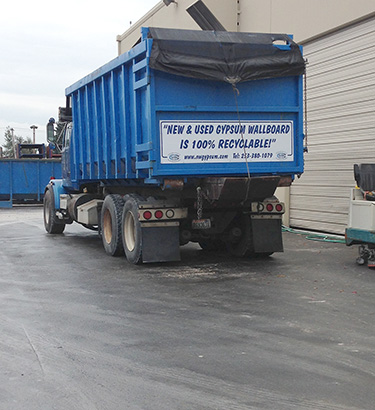|
Subscribe / Renew |
|
|
Contact Us |
|
| ► Subscribe to our Free Weekly Newsletter | |
| home | Welcome, sign in or click here to subscribe. | login |
Construction
| |
 |
April 29, 2016
Drywall can be reused, again and again
New West Gypsum Recycling

McKitterick
|
Sustainable purchasing is a growing global trend resulting in manufacturers creating more closed-loop products. For some, this just brings to the forefront the actions their companies made years ago.
In Seattle, CertainTeed Gypsum is one of these companies. CertainTeed has been working with New West Gypsum, a gypsum wallboard recycling company, to create a closed-loop system for the infinite reuse of drywall.
What is closed loop?
“Closed loop” is a production process in which post-consumer waste is collected, recycled and used to make new products.
When something gets recycled, a common misconception is that it gets easily and immediately turned right back into the same thing it was. The reality is many materials are “down-cycled,” meaning they are converted into new materials that are usually of a lesser quality or reduced functionality.
For a closed-loop system to work properly, consumers, recyclers and manufacturers must work hand-in-hand to reclaim valuable resources from our waste stream and be committed to making new products with them. When in proper working order, this closed-loop recycling system becomes the backbone to manufacturers’ supply chains. To keep the reclaimed material in the closed-loop system infinitely, it is paramount that manufacturers put a premium on designing products for recyclability.
What is drywall?
Drywall is made of an inner layer of gypsum including various additives, sandwiched between two outer layers of lining paper with varying designs for weight, strength and sound proofing dependent on the product’s usage. North America is one of the largest drywall users in the world and an average new American home contains more than 8 tons of it.
Why recycle drywall?
Recycling drywall reduces the need to quarry and produce virgin gypsum.
Drywall should be recycled because of environmental concerns that arise when it is sent to a landfill. The primary component of drywall is calcium sulfate dehydrate, commonly called gypsum. When gypsum is mixed with other materials in the moist, airless, carbon-containing environment often found in a landfill, the sulfates convert to toxic hydrogen sulfide gas.
Decomposing gypsum can release up to a quarter its weight in hydrogen sulfide. Moreover, bacteria that thrive in this environment will convert the paper liner in the drywall to methane, which is a greenhouse gas.
Due to these environmental concerns, more than 30 years ago government in greater Vancouver, B.C., banned gypsum wallboard from landfills.
This ban prompted Tony and Gwen McCamley to create New West Gypsum Recycling. Working with a local manufacturer in British Columbia, at that time called Domtar and now Georgia-Pacific, the McCamleys found that old drywall could be reused in the production of new drywall without detrimental impact on the production or quality of the new product.
The ideal solution for gypsum is a closed-loop reutilization of the material. That is, recycled material is returned to the wallboard manufacturer to re-enter the manufacturing process — so ensuring gypsum is not “lost” as it is with composting or land spreading. Gypsum can essentially be recycled forever with no degradation to the material.
New West Gypsum’s philosophy keeps gypsum in the supply chain, reducing the need to extract virgin material and helping to preserve valuable natural resources for generations to come.
What is sustainability?
Sustainability is defined as “development that meets the needs of the present without compromising the ability of future generations to meet their own needs.”
Sustainable construction aims to meet present day needs for housing, working environments and infrastructure without compromising the ability of future generations to meet their own needs.
Recycling drywall supports the commitment of governments, companies and individuals to sustainability and the environment.
Can I make a difference?
By purchasing products containing recycled materials we are increasing demand for these products, and providing a use for the recyclable materials that companies and communities collect. The benefit of increased demand in closed-loop products is the opportunity for manufacturers to show their commitment in the management of products — from inception through design and manufacturing to service and disposal or recycling.
Cheryl McKitterick is a 26-year veteran of the construction recycling industry. She lives in British Columbia.
Other Stories:
- Suspended Ceiling Commercial Washington
- It’s a Renaissance: stucco and terrazzo are back
- Exterior Commercial Alaska
- Exterior Renovation Commercial Oregon
- Exterior Panelization Oregon
- Exterior Commercial Oregon
- Interior Residential Oregon
- Interior Renovation Commercial Oregon
- Interior Restoration Commercial Oregon
- Interior Commercial Oregon
Light-Gauge Steel Framing Commercial Oregon - Suspended Ceiling Commercial Oregon
- Interior Commercial Eastern Washington
- Exterior Panelization Washington
- Exterior Commercial Washington
- Interior Commercial Washington
Light-Gauge Steel Framing Commercial Washington - Renovation/Restoration Commercial Washington
- Now arriving at UW Station: artistic walls



